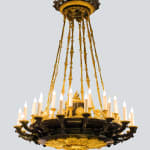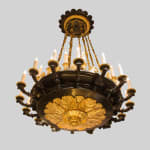Unknown
Provenance
Hélène Rochas (1927-2011), hanging in the dining room of her apartment at rue Barbet de Jouy, Paris.
Literature
Hans Ottomeyer and Peter Pröschel, “Vergoldete Bronzen”, 1986, p. 360, pl. 5.11.7, illustrating a slightly earlier Empire gilt and patinated bronze chandelier with palm-shaped finials surmounting the corona, comparable linked suspension rods and a similarly shaped ring but with swan-shaped candle branches.
A magnificent Restauration gilt and patinated bronze thirty-two light chandelier, the corona with a ribbon-wrapped laurel leaf band headed by stylised palmettes, with ornate linked rods suspending an enclosed circular dished tazza headed by sixteen alternating anthemions and foliate-shaped candle holders above and issuing from the underside of the circular dish a further sixteen scrolled foliate candle branches terminated by stiff-leaf vase-shaped nozzles, above an elaborate palmette and foliate boss
Paris, date circa 1820
Height 124 cm, diameter 90 cm.
This extremely handsome chandelier, formerly owned by Hélène Rochas (1927-2011), not only embodies her intrinsic elegance, taste and beauty but also her refined choice in art. Until her death at the age of eighty-four, this chandelier hung in the dining room in her Parisian apartment at rue Barbet de Jouy, in the fashionable 7th arrondissement where had she lived for sixty years. It was in that dining room that she entertained so many of her friends, seated around an oval Louis-Philippe dining table directly beneath the chandelier. Among her many friends was Yves Saint-Laurent who, like her led French fashion and were to influence a far wider international clientele. It was once said of Hélène Rochas that she “was regarded as, and still remains, the embodiment of Parisian elegance and perfection; her refined taste was bold and sober, and epitomised French style at its best”. Certainly this chandelier epitomised that taste.
Born in 1921 as Nelly Brignole, she studied dance at l’école de danse de l’Opéra de Paris, acting at Cours d’art dramatique René-Simon and was still a teenager when she met the fashion designer and couturier Marcel Rochas (1902-55) whom she married soon after. With her marriage she changed her name to Hélène, which she considered more elegant than Nelly and having become her husband’s muse and model, she also gave up her acting career, even though she was offered a role in Jacques Becker’s ‘Golden Helmet’. When her husband died in 1955, ‘la belle Hélène’, as she was also known, took over the Rochas perfume brand; she propelled it into a flourishing international company and enjoyed several successful launches of new fragrances including Madame Rochas (1960) and Eau de Rochas (1970).
She also began developing her own and extremely impressive, yet eclectic, collection of fine and decorative arts. Her unique French taste blossomed beyond the strong foundations originally set by the Parisian social elite at the turn of the twentieth century and further developed by the influences of wealthy foreigners, aesthetes, and collectors who followed the examples of Carlos de Beistegui, Arturo Lopez-Willshaw, Antenor Patiño or even took inspiration from the more modern tastes of Eugénia Errázuriz and Cole Porter. Their style was quite unique as it differed from that of the big aristocratic collections as well as from those amassed by the French financial and industrial bourgeoisie. As such her collection was extremely varied, ranging from eighteenth century Louis XV furniture to contemporary American paintings. Among the latter were four portraits by Andy Warhol, which she commissioned when living in New York in 1974, while other modern works included a 1925 oil painting by Wassily Kandinsky as well as a large 1954 terracotta vase by Picasso which stood in splendour in her living room upon on one of a pair of Neoclassical side tables. Of the same period were a pair of gilt bronze Neo-classical candelabras that had come from Harewood Castle in Yorkshire, England as well as a large number of Art Deco furnishings and furniture.
Likewise, she was eager to acquire works from the Empire and Restauration period, a taste that was initially inspired and encouraged by her husband’s friend - the interior designer and decorator Georges Geffroy. Among such pieces the present chandelier embodied her love of this style and as such hung in pride of place in her dining room. As a grand society hostess, she entertained so many of her friends there, counting among them Hubert de Givenchy, Yves Saint-Laurent and Maria Callas. Like other rooms in her apartment at rue Barbet de Jouy, images of her dining room often featured in fashion and architectural magazines, where one could see the chandelier hanging above her Louis-Philippe dining table surrounded by Louis XV high back chairs, while on the walls above the fireplace and door were trompe l’oeil panels as well as a painting by François-Louis Schmied which perfectly accorded with a George III tureen placed upon a nineteenth century pedestal table.
Madame Rochas was not only able to afford the very best quality objects but her discriminating eye ensured that she only acquired objects of the utmost taste and beauty. This chandelier is undoubtedly no exception. Given its quality, overall bold form yet refined lines, it can be attributed to the very finest firm of Parisian bronziers of the period, namely Thomire et Cie, whose repertoire included a wide range of lights from chandeliers to lavish candelabra as well as classical vases, sumptuous centrepieces and other luxury pieces. As Napoleon Bonaparte’s favourite makers, Thomire supplied numerous bronzes for the Imperial palaces in France and throughout his Empire. This celebrated firm was founded by Pierre-Philippe Thomire (1751-1843) who was born into a family of ciseleurs and began working with the renowned bronzier Pierre Gouthière (1732-1813) as well as Jean-Louis Prieur (b. 1725 d. after 1785) ciseleur-doreur du roi, before opening up his own workshop in 1776. Famed for his production of finely chased gilt bronze objets de luxe, of which a large quantity were commissioned by the royal household, Thomire frequently collaborated with the marchands-merciers, such as Simon-Philippe Poirier and his successor Dominique Daguerre. In addition, Thomire supplied finely chased mounts to leading ébénistes of his day such as Guillaume Benneman (maître 1785, d. 1811) and Adam Weisweiler (1744-1820). Thomire also helped establish his name when working at the Sèvres Porcelain Manufactory, firstly as an assistant to its artistic director Jean-Claude Duplessis in making the factory’s mounts and then following the latter’s death in 1783, he took over Duplessis’s job and in this capacity supplied all the gilt bronze mounts for the factory’s porcelain. His post-Revolutionary success somewhat eclipsed his fame during Louis XVI’s reign and in 1806 he became the first bronzier to be awarded a gold medal at the Exposition des Produits de l’Industrie. He won another gold medal in 1809, in which year he was also appointed ciseleur de l’Empereur.
In response to growing demand Thomire became an associate and then in 1804 purchased the extensive business owned by Martin-Eloi Lignereux, the famous marchand-mercier, formerly associated with Daguerre. Soon his newly named company Thomire-Duterme et Cie was employing a work force of about 800; it had a workshop at rue Boucherat and a showroom at rue Taitbout, from where Thomire retailed a large range of decorative objects inspired by antiquity including candelabra, extravagant centrepieces, monumental Greek shaped urns and clock cases. Like many Parisian trades, the firm encountered financial difficulties due Napoleon’s continuing wars. Soon after 1815 the partnership with Duterme was dissolved and under its new style, Thomire et Cie thrived once more under the restored Bourbons. 1823 saw Thomire winning a gold medal for sculpture in Paris as well as his retirement from the firm though he continued to produce sculptures and regularly exhibited at the Paris Salon until 1834. His business was continued by his two sons-in-law up until 1852 though Thomire’s legacy has continued for much longer.



